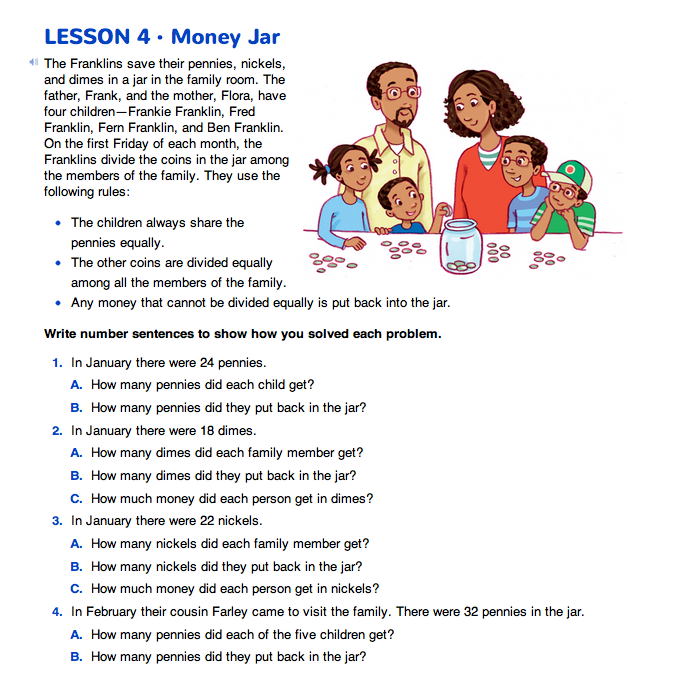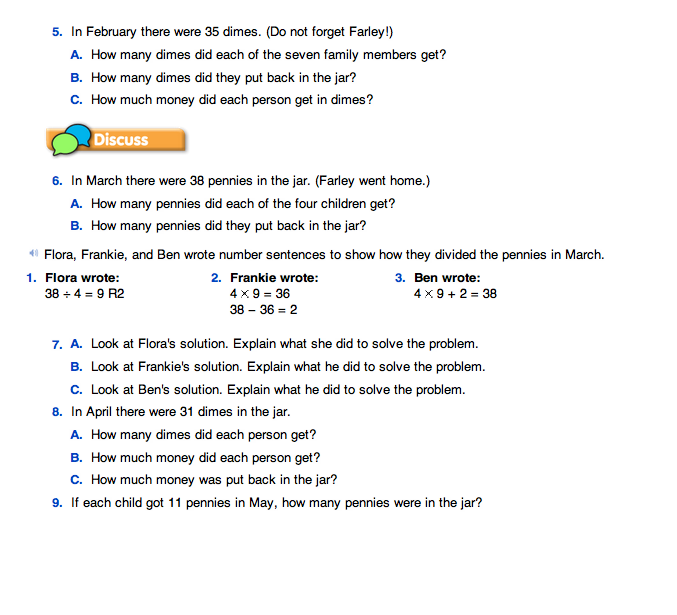Divide Coins. Read the short story about the Franklins on the Money Jar pages in the Student Guide. The Franklins save their coins in a jar. Once each month they divide the coins among the family members. Pennies are divided among the four children. Nickels and dimes are divided among all the family members. Any leftovers are returned to the jar.
Distribute the collection of coins or copies of the Pennies, Nickels, and Dimes Masters to each group. Encourage students to use the money as manipulatives to solve the problems. Since there are four children in the Franklin family, put students into groups of four so each member of the group can act as one of the children.
Allow students to use a collection of real, plastic, or paper coins from the Pennies, Nickels, and Dimes Masters for support in solving the multiplication and division problems in this lesson.
Assign Questions 1–10. In Question 2, the family divides 18 dimes among six people. To determine how much money each person gets, students can use the coins to distribute the dimes equally. They should find that 18 dimes divided among six people means each person has three (18 ÷ 6 = 3). Therefore, each person gets thirty cents.
Allow students to develop their own methods for sharing the coins. Some groups may pass out the appropriate coins one by one to each member of the group until all the coins have been distributed. Others may start with a guess, such as two coins per child, and then adjust the number of coins as needed. For some problems, students may have had enough experience with the numbers to use number sentences immediately.
Students must also interpret the remainders. In Question 3 the family divides 22 nickels among the six members. In this case, each person gets 3 nickels or 15 cents, and 4 nickels are returned to the jar.

Classroom Management. For this activity, four seems to be the maximum number of students for a good working group. If more than four students work together, you will often see at least one student in the group who is not fully participating in the activity. Student pairs are also effective.
The following job assignments for student groups have proven successful during group problem solving:
- Reader
- Reads each question before the group begins solving the problem.
- Checker
- Makes sure each member of the group has a written solution to the problem before the reader reads the next problem.
- Reporter
- Presents the group's solution to the rest of the class. The reporter is the only member of the group who can ask the teacher questions. This forces students to ask questions of their fellow classmates before turning to the teacher for help.
- Materials Gatherer
- Gets all the handouts, manipulatives, or calculators for the group.
All students are expected to participate in the problem solving and related discussion within the group.
Explain Numbers and Symbols in Number Sentences. As students work on the problems, talk with individual groups, asking them how they are solving the problems. In this way you can help them verbalize the division process. Ask them to explain their methods for dividing the coins evenly and interpreting the remainders. Then ask them to match their work with manipulatives to the numbers in their number sentences.
Sample discussion prompts for these conversations follow:
- How many coins do you have to share for this problem? How many people will get a share?
- How are you dividing the coins so that each person gets a fair share?
- What will the Franklins do with the leftover coins? How many do you have left over?
- Show me how the coins that you have divided into groups match the numbers in your number sentence.
More than one number sentence is possible for each problem. For example, Question 6 requires students to divide 38 pennies among four children. Students may see the problem as repeated subtraction and write their solution as shown in Figure 1.
As a division sentence, this can be written as 38 ÷ 4 = 9 R2. The corresponding multiplication sentence is 9 × 4 + 2 = 38. Students can use other combinations of addition, subtraction, and multiplication to record their solutions.
Have a class discussion highlighting the relationships between the various number sentences. Ask the reporter from each group to display their group's number sentence for Question 6.
- What do you notice about the number sentences? (Responses will vary. Possible response: Some use subtraction, and some use addition and multiplication. They all have some of the same numbers in them.)
- What does the 38 in each of the number sentences represent? (total number of pennies)
- What does the 4 represent? (number of children who shared the pennies)
- What does the 9 in each of the number sentences mean? (number of pennies in each group or the number each child got)
- What does the 2 in each number sentence represent? (the leftover pennies)
Refer to Question 7 in which Flora, Frankie, and Ben each wrote different number sentences to show how they divided 38 pennies. Ask students to compare the number sentence their group wrote for Question 6 to each of the Franklins'. Then ask students to explain the numbers and symbols in Flora's, Frankie's, and Ben's number sentences.
Interpret Remainders.
Share the following problem with the class:
- The Franklins have 32 nickels. Can you divide the nickels among the 6 family members fairly? (Yes, each person gets 5 nickels.)
- Are there any nickels remaining or left over? (Yes, 2.)
- Is there a way to divide the left over nickels fairly among the 6 family members? Explain. (No, because there are only two nickels which is the same as 10 pennies. You can't divide 10 pennies between 6 people fairly. They should put them back in the jar.)
- Write a number sentence for this problem and explain what each number and symbol means. (Possible response: Five nickels for each of the 6 people plus the 2 leftover nickels is 32 nickels; 5 × 6 + 2 = 32.)

Understanding the Calculator. It is recommended that students use manipulatives for support when solving problems in this lesson. For most students, a collection of coins will provide all the support needed. However, some students struggling with the mental division involved in the problems in this lesson may benefit from using calculators. Be aware that they may have difficulty when faced with the task of interpreting the results. Point out that they will get different results depending on whether they enter the number of coins or the amount of money into the calculator. The table illustrates the different answers students will see on the windows of their calculators and an appropriate interpretation. Experimenting with the calculator in conjunction with using the manipulatives may allow students to explore the decimal representation of money.

If students choose to use calculators, the following problems may help in their understanding of how to interpret the answers displayed on a calculator:
- Jason used a calculator to solve 15 ÷ 6. His calculator read 2.5. How many coins should he give each person? (2 coins per person)
- Linda had 18 dimes to divide between 6 people. She knew 18 dimes was the same as $1.80 so she entered 1.80 ÷ 6. The window showed 0.3. How many dimes should each person get? (3 dimes. The 0.3 on the window means 30 cents.)

Use Check-In: Questions 11–12 in the Student Guide and the corresponding Feedback Box Master to assess each student's ability to meet the following Expectations:
- Multiply and divide using mental math strategies [E3].
- Represent solution strategies for problems involving multiplication [E4].
- Represent solution strategies for problems involving division including interpreting remainders [E5].
Check In: Questions 11–12 can also be used to assess the following Math Practices Expectations:
- MPE1.
- Know the problem.
- MPE2.
- Find a strategy.
- MPE3.
- Check for reasonableness.
- MPE5.
- Show my work.
- MPE6.
- Use labels.
A modified version of the Lesson 6 Buying Giant Gumballs activity provides targeted practice with these expectations. See Lesson 6 Materials Preparation.
Discuss Question 10. It differs from the previous problem in that after the initial division, the money remaining in the jar can still be divided fairly among the family members. After the fifteen dimes have been divided among the six members (15 ÷ 6 = 2 R3), students can trade nickels for the remaining three dimes so that each person can have two dimes and one nickel.
- In Question 10, how many of the 15 dimes were left over? (3)
- Is there a way to divide the left over money fairly among the 6 family members? (Yes. We can trade the 3 dimes for 6 nickels and then give everyone a nickel.)
- How much money will each family member have in total? (2 dimes plus 1 nickel equals twenty-five cents.)


















